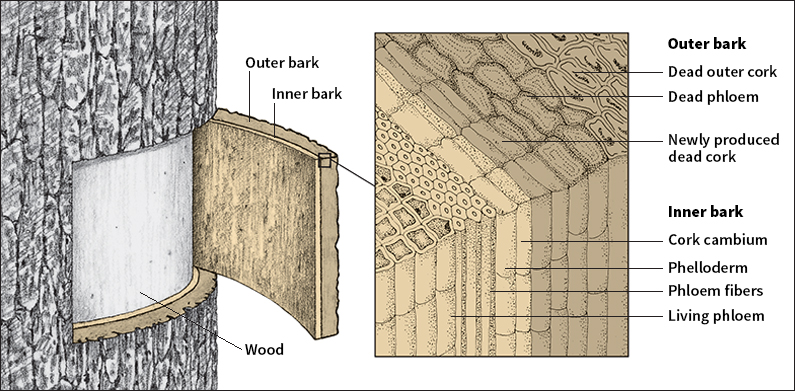Bark is the outer covering of most kinds of trees and shrubs. It protects the stem, roots, and branches from injury, insects, disease, and loss of water. Tissues in bark also carry sugar from the leaves to other parts of the plant.
Bark is made up of circular layers of tissues that lie outside the woody core of trees and shrubs. These tissues are divided into two parts, inner bark and outer bark. Tissues in the inner bark transport and store food. The outer bark serves as a protective covering for the plant.

Most trees and shrubs begin to develop bark during their first year. New layers of inner and outer bark form every year, and the bark gradually grows thicker.
Inner bark
is composed of layers of living, growing tissues. These layers, from innermost to outermost, are the (1) phloem, (2) phelloderm, and (3) cork cambium, or phellogen.
Phloem consists primarily of sieve tubes, which conduct sugar down from the leaves. Bands of fibers may support these tubes. The phloem also includes certain other kinds of cells, including companion cells and ray cells. The phloem in mature woody plants is produced by tissue called the cambium, which lies between the wood and the bark. Cell division in the cambium produces new layers of wood and inner bark, and causes the stem of the plant to grow wider. As new phloem accumulates, it pushes the older phloem out and crushes it into the outer bark.
The phelloderm is a layer of food storage cells. It is produced by the cork cambium, which acts similarly to the cambium in the production of new tissues. The growth of new phloem stretches the phelloderm and the cork cambium until they break apart and die. New layers of phelloderm and cork cambium then develop to replace the dead tissues.
Outer bark
consists chiefly of cork, a tough, dead tissue produced by the cork cambium. Patches of dead phloem occur throughout the outer bark of mature trees and shrubs. This dead phloem has been pushed out by the growth of new phloem.
Cork cells have thick walls that contain a waxy, waterproof substance called suberin. Suberin protects the plant from losing water and prevents gases from passing in and out. Gases enter and leave the stem through lenticels, which are round or oval blisters in the surface of the bark. In young stems, the outer bark is also marked by scars at points where buds and leaves were once attached.
Young trees and shrubs have a thin, smooth layer of cork. As the stem of the plant grows wider, this layer splits, and new cork cells develop beneath it. This process continues throughout the life of the plant and causes the outer bark to become rough and scaly. The outer bark of a few kinds of trees remains smooth because it stretches easily. Trees with smooth bark include beeches and birches.
The cork cambium produces a new layer of cork annually. The thickness of the bark of most trees does not increase greatly because they lose some older bark each year. However, the outer bark of a large California redwood can measure more than 2 feet (61 centimeters) thick near its base. This thick outer bark protects the trees from damage caused by the heat of fire.
How people use bark.
Early peoples used bark to make canoes, clothing, and shelters. The bark of many kinds of trees has become commercially valuable through the years and is used in manufacturing a wide variety of products.
Manufacturers use cork from the extremely thick outer bark of the cork oak tree in making bottle stoppers, flooring, insulation materials, and many other products. The bark of certain trees contains tannic acid, a substance used in tanning hides to make leather. The bark of some tropical trees provides substances used in making chewing gum and rubber. Cherry cough medicine and cinnamon also are obtained from bark. Such fabrics as burlap and linen are made from phloem fibers.
